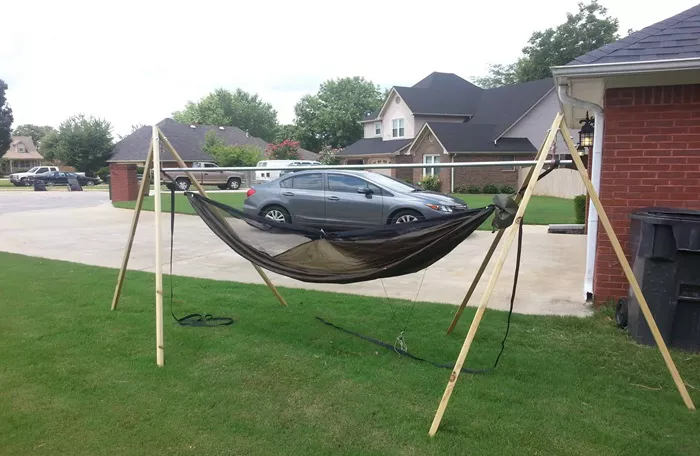Hanging a travel hammock might seem simple, but doing it correctly ensures safety, comfort, and durability. Whether you’re camping, hiking, or just relaxing in your backyard, setting up a hammock properly makes all the difference. This guide covers everything from choosing the right trees to advanced hanging techniques.
Choosing the Right Location
Before setting up your hammock, you need a good spot. Not all trees or anchor points are suitable.
Finding Strong Trees or Supports
- Look for healthy, sturdy trees at least 6 inches (15 cm) in diameter.
- Avoid dead or rotting trees—they can break under weight.
- If trees aren’t available, use strong posts, rock formations, or hammock stands.
Checking the Distance
- Most hammocks need 10-15 feet (3-4.5 meters) between anchor points.
- Adjust based on your hammock’s length and suspension system.
Avoiding Environmental Damage
- Use wide straps (at least 1 inch wide) to protect tree bark.
- Never use ropes or thin cords that can cut into trees.
- Follow Leave No Trace principles to minimize impact.
Essential Gear for Hanging a Hammock
Having the right equipment ensures a secure and comfortable setup.
Hammock Straps or Suspension System
- Tree Straps: Wide, adjustable straps with loops for easy setup.
- Whoopie Slings: Lightweight, adjustable ropes for advanced users.
- Carabiners & Daisy Chains: Quick-adjust systems for easy hanging.
Structural Support (If No Trees Are Available)
- Portable Hammock Stands: Freestanding frames for open areas.
- Tensioned Ridgelines: Helps maintain the perfect sag.
Additional Accessories
- Bug Net: Essential for mosquito-prone areas.
- Rain Tarp: Provides shelter in wet weather.
- Underquilt or Sleeping Pad: Insulation for cold nights.
Step-by-Step Hanging Instructions
Follow these steps for a safe and comfortable setup.
Step 1: Attach the Straps to Anchor Points
- Wrap the straps around trees at about eye level (5-6 feet high).
- Adjust height based on hammock length—longer hammocks need higher anchors.
Step 2: Connect the Hammock
- Use carabiners to attach the hammock ends to the straps.
- Ensure connections are secure before sitting.
Step 3: Adjust the Sag
- A 30-degree angle between strap and ground is ideal.
- Too tight = uncomfortable; too loose = hard to balance.
Step 4: Test Before Full Use
- Sit gently to check stability.
- Adjust straps if the hammock feels unstable.
Advanced Hanging Techniques
For those who want to optimize comfort, try these tips.
Using a Ridgeline
- A fixed-length rope between hammock ends ensures consistent sag.
- Prevents over-tightening and improves comfort.
Angle and Height Adjustments
- Higher attachment points allow for a looser, more comfortable hang.
- Lower points work better for stability in windy conditions.
Multiple Hammock Setups (Stacking or Side-by-Side)
- Use spreader bars for multiple hammocks on the same trees.
- Ensure trees are strong enough to hold extra weight.
Common Mistakes to Avoid
Even experienced campers make errors. Here’s what to watch for.
Hanging Too Tight
- Causes excessive pressure on fabric and anchor points.
- Leads to discomfort and potential damage.
Using Weak or Damaged Trees
- Always check tree health before hanging.
- Avoid trees with cracks or loose bark.
Ignoring Weather Conditions
- Wind can flip an improperly secured hammock.
- Rain requires a tarp setup to stay dry.
Safety Tips for Hammock Camping
Stay safe with these best practices.
Weight Limits
- Check manufacturer ratings—most hammocks hold 300-500 lbs.
- Avoid overloading with gear or multiple people.
Fall Protection
- Hang close to the ground to reduce injury risk.
- Use a padded mat underneath for extra safety.
Wildlife Considerations
- Avoid hanging near animal trails or nests.
- Store food away from your hammock to prevent unwanted visitors.
Conclusion
Hanging a travel hammock correctly ensures comfort, safety, and environmental responsibility. By choosing strong anchor points, using the right gear, and following proper techniques, you can enjoy a relaxing outdoor experience. Whether you’re a beginner or an expert, these tips will help you set up your hammock like a pro.
Now, grab your gear, find the perfect spot, and start hammocking the right way!
Related topics:
Mastering the Art of Hanging a Travel Hammock
Best Lightweight Camping Hammocks: A Complete Guide
Best Portable Hammock: A Detailed Guide to Comfort on the Go

